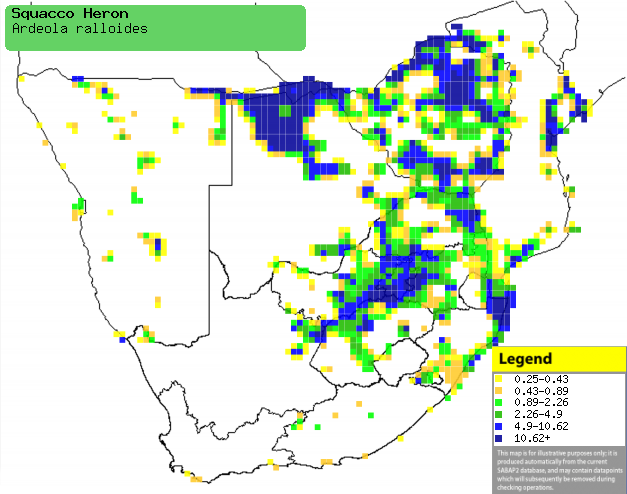|
Ardeola ralloides (Squacco
heron, Common
squacco heron)
Ralreier [Afrikaans]; Hakaruu (generic term for
short-necked herons and bitterns) [Kwangali]; Kokolofitoe (generic term
for heron) [South Sotho]; Ralreiger [Dutch]; Crabier chevelu [French];
Rallenreiher [German]; Garça-caranguejeira [Portuguese]
Life
> Eukaryotes >
Opisthokonta
> Metazoa (animals) >
Bilateria >
Deuterostomia > Chordata >
Craniata > Vertebrata (vertebrates) > Gnathostomata (jawed
vertebrates) > Teleostomi (teleost fish) > Osteichthyes (bony fish) > Class:
Sarcopterygii (lobe-finned
fish) > Stegocephalia (terrestrial
vertebrates) > Tetrapoda
(four-legged vertebrates) > Reptiliomorpha > Amniota >
Reptilia (reptiles) >
Romeriida > Diapsida > Archosauromorpha > Archosauria >
Dinosauria
(dinosaurs) > Saurischia > Theropoda (bipedal predatory dinosaurs) >
Coelurosauria > Maniraptora > Aves
(birds) > Order: Ciconiiformes
> Family: Ardeidae
Distribution and habitat
Occurs from southern Europe to northern and
sub-Saharan Africa. In southern Africa, it
is locally common in the Caprivi Strip (Namibia), northern and south-eastern
Botswana, Zimbabwe, central and southern Mozambique and South Africa. It generally prefers still freshwater habitats
with dense fringing vegetation; flooded grassland and temporary pans with
emergent vegetation.
|
 |
|
Distribution of Squacco heron in southern Africa,
based on statistical smoothing of the records from first SA Bird Atlas
Project (©
Animal Demography unit, University of
Cape Town; smoothing by Birgit Erni and Francesca Little). Colours range
from dark blue (most common) through to yellow (least common).
See here for the latest distribution
from the SABAP2. |
Movements and migrations
Resident and sedentary in permanent wetlands
but nomadic elsewhere, moving in response to new temporary water
bodies.
Food
It mainly eats a variety of small aquatic animals, doing
most of its foraging at the water's edge, creeping through the water with its
head held forward, ready to strike. The following food items have been recorded
in its diet:
- Vertebrates
- Invertebrates
Breeding
- Monogamous and usually colonial, living in small to large colonies, often
alongside other bird species.
- The nest is built by the male in roughly 1-3 days, displaying on it
until a female joins him to start a family. It consists of a compact
platform of thin sticks and reeds, lined with grass and placed in a reedbed,
bush or tree over water.
- Egg-laying season is almost year-round, peaking from August-March in
Zimbabwe and South Africa and from March-August elsewhere in southern
Africa.
- It lays 2-4 eggs, which are incubated by both sexes for roughly 18-24
days (recorded in Madagascar and Europe).
- The chicks are fed by both parents, leaving the nest after about 35 days,
but only flying approximately 20 days later.
Threats
Not threatened.
References
-
Hockey PAR, Dean WRJ and Ryan PG 2005. Roberts
- Birds of southern Africa, VIIth ed. The Trustees of the John Voelcker
Bird Book Fund, Cape Town.
|
